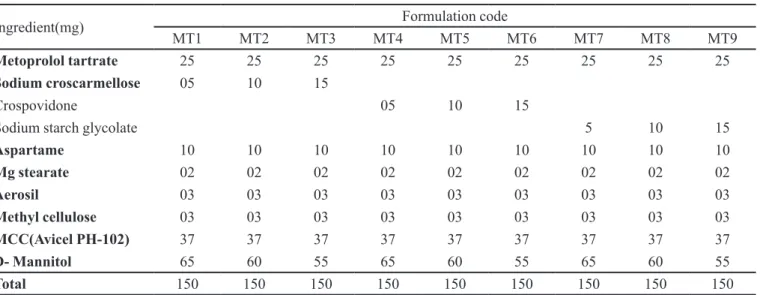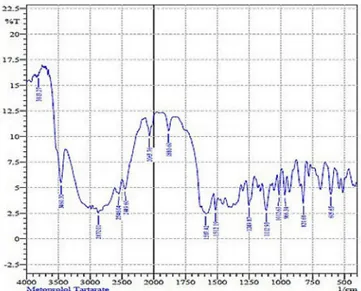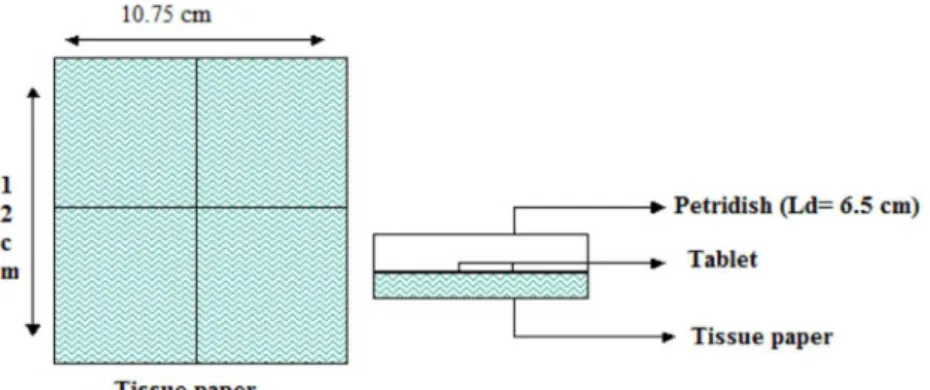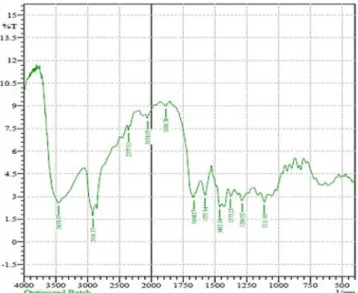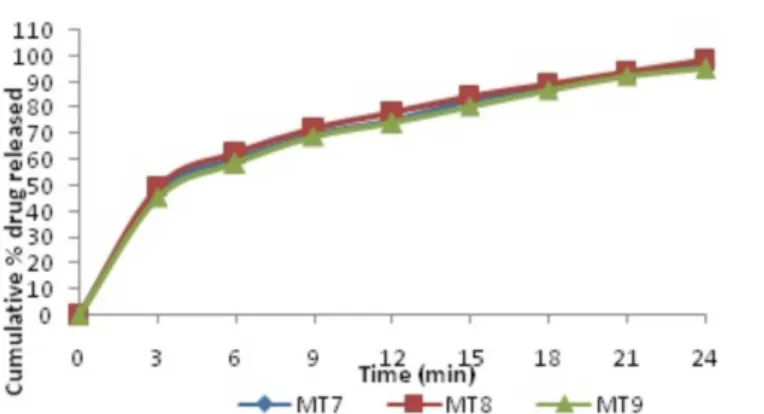*Correspondence: Mangesh M. Satpute. Department of Pharmaceutics, K. T. Patil College of Pharmacy, 413 501 - Osmanabad - Maharashtra, India. E-mail: mangesh9787@gmail.com
A
vol. 49, n. 4, oct./dec., 2013
Formulation and
in vitro
evaluation of fast dissolving tablets of
metoprolol tartrate
Mangesh Machhindranath Satpute
*, Nagesh Shivaji Tour
Department of Pharmaceutics, K. T. Patil College of Pharmacy, India
The demand for fast dissolving tablets has been growing during the last decade, especially for elderly and children who have swallowing dificulties. In the present work, fast dissolving tablets of metoprolol tartrate, were prepared using sodium starch glycolate, sodium croscarmellose and crospovidone as superdisintegrants, by the direct compression method. The tablets prepared were evaluated for various parameters including weight variation, hardness, friability, in vitro dispersion time, drug-polymer interaction, drug content water absorption ratio, wetting time, in vitro drug release, FTIR and DSC studies. The tablets prepared by the direct compression method had a weight variation in the range of 145 mg to 152 mg, which is below ± 7.5%, a hardness of 3.6 kg/cm2 to 4.5 kg/cm², percentage friability of 0.46% to 0.73%, in vitro dispersion time of 18 s to 125 s, drug content uniformity of between 98.12% and 100.03%, a water absorption ratio of 67% to 87%, wetting time of 32 sec. to 64 sec., and an in vitro drug release of 53.92% - 98.82% within 15 min. The IR spectral analysis and DSC study showed no drug interaction with formulation additives of the tablet, and the formulations indicated no signiicant changes in hardness, friability, drug content or in vitro drug release. Fast dissolving tablets of metoprolol tartrate have enhanced dissolution and will lead to improved bioavailability and more effective therapy.
Uniterms: Fast dissolving tablets/in vitro evaluation. Fast dissolving tablets/formulation. Metoprolol tartrate/fast dissolving tablets/formulation. Metoprolol tartrate/in vitro evaluation. Sodium croscarmellose. Sodium starch glycolate. Crospovidone. In vitro dispersion time/tablets evaluation.
A exigência por comprimidos de dissolução rápida aumentou durante a última década, especialmente para idosos e crianças, com diiculdades de deglutição . No presente trabalho prepararam-se, pelo método de compressão direta, comprimidos de tartarato de metoprolol de rápida dissolução, utilizando glicolato sódico de amido, croscarmellose sódica e crospovidona como superdisintegrantes. Os comprimidos preparados foram avaliados em relação a diferentes parâmetros, como variação de peso, dureza, friabilidade, tempo de dispersão in vitro, interação fármaco-polímero, taxa de absorção de água pelo fármaco, tempo de umedecimento, liberação do fármaco in vitro,, FTIR e estudos de DSC. Os comprimidos preparados por compressão direta apresentaram variação de peso de 145 mg a 152 mg, abaixo de ±7,5%, dureza de 3,6 kg/cm² a 4,5 kg/cm² , porcentagem de friabilidade de 0,46% a 0,73%, tempo de dispersão in vitro de 18 s a 125 s, uniformidade de conteúdo de fármaco entre 98,12% e 100,03%, taxa de absorção de água de 67% a 87%, tempo de umidiicaçãode 32 s a 64 s liberação do fármaco in vitro entre 53,92% e 98,82%, em 15 min. A análise no IV e de DSC mostrou que não houve interação de fármacos com os aditivos de formulação do comprimido e as formulações indicaram que não houve mudança signiicativa na dureza, friabilidade, s uniformidade de conteúdo de fármaco e na liberação do fármaco in vitro. Os comprimidos de liberação rápida apresentaram aumento na dissolução de tartarato metoprolol e conduzem à melhoria dabiodisponibilidade e à terapia eicaz.
INTRODUCTION
Elderly people, children and patients sometimes have difficulties swallowing tablets or hard gelatin capsules. In addition, such difficulties apply not only to patients but also to active working people who have no access to water. These problems can be resolved by means of tablets which disintegrate rapidly in the mouth (Sugimoto et al., 2006).
Recently, fast dissolving tablets (FDTs) have become increasingly popular around the world. On the basis of requests from patients to enhance their quality of life (QOL), new types of FDTs have been developed and then released globally by many pharmaceutical companies (Okuda et al., 2011). These tablets display a fast and spontaneous de-aggregation in the mouth, soon after coming into contact with saliva, dissolving the active ingredient and allowing absorption through all possible membranes it comes into contact with during deglutition (Puttewar et al., 2010).
Fast dissolving tablets are useful for patients with dificulties swallowing conventional tablets, for example pediatric patients and patients under chemotherapy treatment. Patients on chemotherapy treatment may have nausea which is so intense that it complicates the administration of conventional tablets; typically this has been done with water, especially in those with tumors of the mouth and esophagus. Nausea and emesis continue to cause significant problems for patients with cancer receiving highly or moderately emetogenic chemotherapy (Armando et al., 2009). Direct absorption through the oral mucosa allows drugs to achieve systemic circulation, bypassing the gastrointestinal tract and the first-pass metabolism of the liver. To allow fast dissolving of dosage forms in the mouth, these delivery systems comprise either very porous and soft-moulded matrices or compression into tablets with very low compression force (Lai et al., 2011).
However, as a result of rapid FDT disintegration, the active substance comes into contact with the taste buds and the need for a pleasant taste becomes a key aspect for patient palatability. Thus, the taste-masking of bitter active substances is a critical hurdle to overcome for the successful development of FDT formulations. In general, oral administration of bitter active substances through FDT formulations should provide an improved degree of palatability and increased patient compliance with dissolving/disintegrating tablets that include sweeteners and flavors. Nevertheless, these additives were not a sufficient means for complete taste-masking. Recent advances in technology have presented viable dosage
alternatives to taste-mask bitter drugs. Several approaches have been reported which involve complexation, freeze-drying, microencapsulation, luidized-bed coating and supercritical luids for taste-masking purposes (Gryczkc et al., 2011).
MATERIAL AND METHODS
Metoprolol tartrate was obtained from Cipla Pharma, Mumbai, India. Crospovidone, sodium starch glycolate and sodium croscarmellose were also obtained from Cipla Pharma Mumbai, India. Microcrystalline cellulose and mannitol were obtained from Ajantha Pharma, Aurangabad. All other chemicals of analytical grade were purchased from commercial sources.
Preparation of fast dissolving tablets by direct compression method
Fast dissolving tablets of metoprolol tartrate were prepared by direct compression. All the ingredients (except granular directly compressible excipients) were passed through # 60-mesh separately. The ingredients were then weighed and mixed in geometrical order and compressed into tablets of 150 mg using 6 mm round concave punches on an 8-station rotary tablet machine (Karnavati) (Shirsand
et al., 2010) (Table I).
Evaluation of metoprolol tartrate fast dissolving tablets
Evaluation of pre-compression parameters of powder • Preformulation study
• Angle of repose (θ)
The angle of repose was determined by using the funnel method. The accurately weighed blend was taken in a funnel. The height of the funnel was adjusted in such a way that the tip of funnel just touched the apex of the heap and the drug-excipient blend was allowed to low through the funnel freely to the surface. The diameter of the powder cone was measured and angle of repose calculated using the following equation.
Tan θ = h/r
Different ranges of flowability in terms of angle of repose (Table II) are given below (Bikshapathi et al., 2011).
• Bulk density (Pb)
TABLE I - Formulation of metoprolol tartrate fast dissolving tablets prepared by direct compression method
Ingredient(mg) Formulation code
MT1 MT2 MT3 MT4 MT5 MT6 MT7 MT8 MT9
Metoprolol tartrate 25 25 25 25 25 25 25 25 25
Sodium croscarmellose 05 10 15
Crospovidone 05 10 15
Sodium starch glycolate 5 10 15
Aspartame 10 10 10 10 10 10 10 10 10
Mg stearate 02 02 02 02 02 02 02 02 02
Aerosil 03 03 03 03 03 03 03 03 03
Methyl cellulose 03 03 03 03 03 03 03 03 03
MCC(Avicel PH-102) 37 37 37 37 37 37 37 37 37
D- Mannitol 65 60 55 65 60 55 65 60 55
Total 150 150 150 150 150 150 150 150 150
Formulation code: MT1 - Formulation containing 3.3% sodium croscarmellose; MT 2 - Formulation containing 6.6% sodium croscarmellose; MT 3 - Formulation containing 10% sodium croscarmellose; MT 4 - Formulation containing 3.3% crospovidone; MT 5 - Formulation containing 6.6% crospovidone; MT 6 - Formulation containing 10% crospovidone; MT 7 - Formulation containing 3.3% sodium starch glycolate; MT 8 - Formulation containing 6.6% sodium starch glycolate; MT 9 - Formulation containing 10% sodium starch glycolate.
TABLE II - Relationship between angle of repose (θ) and low
properties
Angle of repose (θ) (degrees) Flow
<25 Excellent
25-30 Good
30-40 Passable
>40 Very poor
volume (Vb) and weight of powder (M) was determined. The bulk density was calculated using the formula (ShahV et al., 2011).
Pb = M/Vb
• Tapped density (Pt)
The measuring cylinder containing a known mass of blend was tapped for a fixed time. The minimum volume (Vt) occupied in the cylinder and the weight (M) of the blend was measured. The tapped density (pt) was calculated using the formula (Suresh et al., 2011).
Pt = M/Vt
• Hausner’s ratio
Hausners’s ratio is the ratio of tapped density to bulk density. The lower the value of Hausner’s ratio the better the low property. The ratio is calculated by the following formula
Lower Hausner ratios (<1.25) indicate better low properties than higher ratios (>1.25) (Sayeed et al., 2011).
• Carr’s compressibility index
The percentage compressibility (Carr’s index) was calculated as 100 times the ratio of the difference between tapped density and bulk density to tapped density (Sayeed et al., 2011). (Table III).
It is expressed in percentage and calculated by the following formula
TABLE III - Grading of the powders for their low properties
according to Carr’s index
Consolidation index (Carr’s %) Flow
5 – 15 12 – 16 18 – 21 23 – 35 33 – 38 >40
Excellent Good Fair to passable
Drug polymer interaction studies • FTIR study
The study was carried out to determine the molecular structure, serving as an identiication test to ascertain the purity of the molecule. IR spectroscopy was obtained by a FTIR spectrophotometer (H400-84100, Shimadzu, Japan) using KBr pellets. The scanning range used was 4400 to 400 cm-1 at a scan period of 1min. Spectra of pure drug and the blend are shown in Figures 1 and 2. There is no change in the shape of the peak or shift of the peak, hence the drug and excipients are compatible ( Prameela et al., 2010).
• Differential scanning calorimetry (DSC) Study DSC analysis of pure drug, and of the optimized formulation was performed on a Shimadzu DSC 60 thermal analyser at the heating low rates of 5 °C per min between 50-300 °C under static air using aluminium pans (Nayak et al., 2011).
Evaluation of post-compression parameters of tablets
• Hardness test
The hardness of a tablet is indicative of its tensile strength and is measured in terms of load/pressure required to crush it when placed on its edge. A number of handy hardness testers such as the Mosanto type or Pfizer type are currently in use. Hardness of about 5 kg is considered to be a minimum for uncoated tablets for mechanical stability. The hardness is a function of physical properties of granules such as hardness and deformation under load, binders and above all the compressional force. The hardness has an inluence on disintegration and dissolution times and is, as such, a factor that may affect bioavailabilities (Puttewar et al., 2010).
• Friability test
Friability of the tablets was determined using a Roche friabilator. This device subjects the tablets to the combined effect of abrasions and shock in a plastic chamber revolving at 25 rpm, dropping the tablets from a height of 6 inches on each revolution. A preweighed sample of tablets was placed in the friabilator and subjected to 100 revolutions. Tablets were de-dusted using a soft muslin cloth and reweighed.
The friability (F%) is given by the formula
Where, W0 is weight of the tablets before the test and W is the weight of the tablets after the test (Mehta et al., 2009).
• Weight variation test
Twenty tablets were selected randomly and average weight was determined. Subsequently, individual tablets were weighed and compared with average weight. If the comparison variation lies within the I.P limits, it passes the weight variation test (Chandira et al., 2010).
• Water absorption
A piece of tissue paper folded twice was placed in FIGURE 1 - FT-IR spectrum of metoprolol tartrate.
a small Petri dish containing 6 ml of water. A tablet was placed on the paper and the time required for complete wetting was measured. The wetted tablet was then weighed. Water absorption ratio is indicated by R, which is calculated by using the equation below (Chandira et al., 2010).
• Uniformity of thickness
Thickness can be measured using a simple procedure. A total of 5 tablets were taken and their thicknesses measured using Vernier calipers. The thickness was measured by placing the tablet between the two arms of the Vernier calipers (Parmar et al., 2009).
• Drug content uniformity
The formulated tablets were also analyzed for the drug uniformity contents as per the Indian Pharmacopoeia. A total of 20 tablets were taken, weighed and ground. An amount of this powder equivalent to 5 mg of the drug was accurately weighed, suitably diluted and analyzed on a double-beam UV spectrophotometer (Jasco- 630V) at 221.70 nm. (Bagul et al., 2010).
• Wetting time
A piece of double-folded tissue paper was placed in a petri plate (internal diameter 6.5 cm) containing 6ml of water. The tablet was placed on the paper and the time for complete wetting of the tablet was measured in seconds. The method was slightly modified by maintaining water at 37 οC (Figure 3) (Margret et al., 2010).
• In vitro disintegration time
The disintegration time was measured using disintegration test apparatus. One tablet was placed in each tube of the basket. This basket was immersed in a
water bath at 37+ 20 oC. The time required for complete disintegration was recorded with standard deviation (Chacko et al., 2010) (Table VI)
• In vitro dissolution studies
The in vitro dissolution study was performed using an USP dissolution apparatus Type 2 (Paddle type) at 100 rpm using 900 ml phosphate buffer pH 6.8 as the dissolution medium at 37±0.5 ºC. Aliquots of dissolution medium were withdrawn and the absorbances of iltered solutions determined by a UV Spectrophotometer at 221.70 nm. Six trials were performed for each batch and average percentage drug release with standard deviation was calculated and recorded (Chacko et al., 2010).
RESULTS AND DISCUSSION
Fast dissolving tablets of metoprolol tartrate were prepared by a method employing crospovidone, sodium starch glycolate and sodium croscarmellose as super-disintegrants at different ratios. A total of nine formulations were designed. The flow properties of the powder mixture are important for the uniformity of mass of the tablets; the low of the powder mixture was analyzed before compression to tablets. Low Hausner`s ratio (≤1.14), compressibility index (≤15) and angle of repose (≤ 28.04) values indicated fairly good lowability of the powder mixture (Table IV).
As the tablet powder mixture was free flowing, tablets produced were of uniform weight with acceptable weight variation in the range from 145 mg to 152 mg due to uniform die ill. Hardness (3.6 kg/cm2- 4.5 kg/cm2) and friability loss (0.46% - 0.73%) indicated that tablets had good mechanical resistance. Drug content was found to be high (≥ 98.12 %) in all the tablet formulations. Water absorption ratio and wetting time, which are important criteria for understanding the capacity of disintegrants to swell in the presence of a small amount of water, were
found to be in the range of 67.32% - 87.91% and 28 sec - 57 sec, respectively (Tables V and VI).
The most important parameter that needs to be optimized in the development of fast disintegrating tablets is the disintegration time of tablets. In the present study, it was observed that the disintegration time of the tablets had no effect with increasing level of TABLE IV - Pre-compression results of direct compression method
Formulation code Bulk density(g/cc) Tapped density (g/cc) Angle of repose
(degrees)
Carr’s index
(%) Hausner’s Ratio
MT1 0.54 0.65 28.04 16 1.20
MT2 0.52 0.63 30.14 17 1.21
MT3 0.51 0.62 28.85 17 1.21
MT4 0.55 0.65 28.26 15 1.14
MT5 0.50 0.63 28.43 20 1.26
MT6 0.53 0.64 30.01 17 1.20
MT7 0.53 0.63 30.02 15 1.20
MT8 0.51 0.62 28.87 17 1.21
MT9 0.52 0.65 27.52 18 1.21
Formulation code: MT 1 - Formulation containing 3.3% sodium sodium croscarmellose; MT 2 - Formulation containing 6.6% sodium sodium croscarmellose; MT 3 - Formulation containing 10% sodium croscarmellose croscarmellose; MT 4 - Formulation containing 3.3% crospovidone; MT 5 - Formulation containing 6.6% crospovidone; MT 6 - Formulation containing 10% crospovidone; MT 7 - Formulation containing 3.3% sodium starch glycolate; MT 8 - Formulation containing 6.6% sodium starch glycolate; MT 9 - Formulation containing 10% sodium starch glycolate.
crospovidone. The faster disintegration of crospovidone tablets may be attributed to its rapid capillary activity and pronounced hydration with low capacity for gel formation. Thus, these results suggest that disintegration times can be reduced by using a wicking type disintegrant (crospovidone). Thus, wetting times of tablets with crospovidone were found to be less than those with
TABLE V - Post-compressional parameters for direct compression method
Formulation Code Hardness* (kg/cm²)
Mean ± SD Friability (%)
Thickness* (mm)
Mean ± SD
Weight variation (mg)
Mean ± SD
MT1 4.3 ± 0.11 0.46 4.3 ±0.05 146 ± 1.37
MT2 3.7 ± 0.15 0.66 4.2 ±0.07 145 ± 1.35
MT3 3.5 ± 0.15 0.70 4.6 ±0.10 149 ± 1.40
MT4 4.3 ± 0.19 0.60 4.4 ±0.09 148 ± 1.34
MT5 4.1 ± 0.14 0.46 4.1 ±0.20 149 ± 1.31
MT6 4.4 ± 0.23 0.56 4.6 ± 0.10 148 ± 1.40
MT7 4.5 ± 0.07 0.73 4.8 ± 0.10 150 ± 1.24
MT8 4.2 ± 0.10 0.53 4.5 ± 0.11 152 ± 1.35
MT9 3.6 ± 0.19 0.66 4.6 ± 0.05 147 ± 1.36
Values expressed as Mean ± SD (n=3).
TABLE VI - Post-compressional parameters for direct compression method
Formulation Code In vitro dispersion time*
(sec) Wetting time
* (sec) Water absorption ratio* Drug Content* (%)
MT1 35 ± 1.27 49 ± 1.36 84 ± 1.05 99.18 ± 0.72
MT2 92 ± 1.25 46 ± 1.18 74± 0.80 99.81 ± 1.07
MT3 62 ± 1.30 42 ± 1.22 67 ± 1.06 99.54 ± 0.50
MT4 22 ± 1.37 32 ± 1.29 82 ± 1.28 98.12 ± 0.73
MT5 18 ± 1.35 28 ± 1.27 87 ± 1.36 99.30 ± 0.87
MT6 25 ± 1.36 36 ± 1.37 81 ± 1.38 99.23 ± 0.90
MT7 99 ± 1.31 57 ± 1.32 71 ± 1.34 100.03 ± 1.07
MT8 116 ± 1.35 64 ± 1.36 75 ± 1.44 99.63 ± 0.39
MT9 125 ± 1.40 48 ± 1.40 74± 1.31 99.50 ± 0.77
Values expressed as Mean ± SD (n=3).
Formulation code: MT 1 - Formulation containing 3.3% sodium sodium croscarmellose; MT 2 - Formulation containing 6.6% sodium sodium croscarmellose; MT 3 - Formulation containing 10% sodium sodium croscarmellose; MT 4 - Formulation containing 3.3% crospovidone; MT 5 - Formulation containing 6.6% crospovidone; MT 6 - Formulation containing 10% crospovidone; MT 7 - Formulation containing 3.3% sodium starch glycolate; MT 8 - Formulation containing 6.6% sodium starch glycolate; MT 9 - Formulation containing 10% sodium starch glycolate.
sodium starch glycolate or sodium croscarmellose. These results are consistent with disintegration test results. IR shows the drug interaction study, indicating that the drug is compatible with all the excipients (Figures 4 and 5).
The DSC shows that when the drug metoprolol tartrate was taken to study its properties at higher temperature, it exhibited a melting peak at 126.69 oC with very little variation compared with the literature-reported temperature. This is probably due to error in experimental
determination. The DSC of the optimized formulation showed a melting peak at 120.19 oC. DSC studies of all formulations indicated that no chemical constituent produced any reaction products (Figure 6 and 7).
In vitro drug release studies were carried out in phosphate buffer pH 6.8 and the dissolution profile is depicted in Table VII and Figures 8 - 10. The drug release from the optimized batch (MT5) was 98.82% at 15 min.
FIGURE 4 – FT-IR spectrum of metoprolol tartrate with sodium starch glycolate.
FIGURE 6 – DSC analysis of metoprolol tartrate. FIGURE 7 - DSCanalysisof metoprolol tartrate with optimized FDT formulation.
TABLE VII - Dissolution of metoprolol tartrate in phosphate buffer pH 6.8 from tablets of MT1 to MT9
Time (min) Cumulative % Drug release
MT1 MT2 MT3 MT4 MT5 MT6 MT7 MT8 MT9
00 0.00 0.00 0.00 0.00 0.00 0.00 0.00 0.00 0.00
03 50.61 52.34 49.35 52.25 53.92 51.10 47.63 49.35 45.48
06 64.18 65.35 63.40 66.49 68.78 64.92 59.95 62.45 58.56
09 75.64 76.80 75.90 77.95 79.10 75.98 69.96 72.30 68.89
12 88.54 89.72 87.45 92.68 93.90 90.10 75.25 78.23 73.98
15 93.73 94.20 91.10 97.97 98.82 95.52 82.76 84.88 80.54
18 96.51 98.45 95.28 88.34 89.56 87.18
21 93.06 94.12 92.18
24 97.24 98.41 95.13
Formulation code: MT 1 - Formulation containing 3.3% sodium croscarmellose; MT 2 - Formulation containing 6.6% sodium sodium croscarmellose; MT 3 - Formulation containing 10% sodium sodium croscarmellose; MT 4 - Formulation containing 3.3% crospovidone; MT 5 - Formulation containing 6.6% crospovidone; MT 6 - Formulation containing 10% crospovidone; MT 7 - Formulation containing 3.3% sodium starch glycolate; MT 8 - Formulation containing 6.6% sodium starch glycolate; MT 9 - Formulation containing 10% sodium starch glycolate.
FIGURE 8 - In vitro release of metoprolol tartrate from tablets of MT1 to MT3.
CONCLUSION
In the present work, fast dissolving tablets of metoprolol tartrate were prepared by direct compression methods using superdisintegrants such as sodium starch glycolate, sodium croscarmellose and crospovidone. All the tablets of metoprolol tartrate were subjected to tests for weight variation, hardness, friability, in vitro dispersion, drug polymer interaction, drug content uniformity, water absorption ratio, wetting time, and in vitro drug release.
Based on the above studies, the following conclusions can be drawn:
• Tablets prepared by direct compression methods were found to be good and free from chipping and capping.
• The low values of the standard deviation of average weight of the prepared tablets indicated weight uni-formity within the batches prepared.
• The hardness of the prepared tablets was found to be in the range of 3.6 kg/cm2 to 4.5 kg/cm². The friability values of the prepared tablets were found to be less than 1%.
• IR spectroscopic and DSC studies indicated that the drug is compatible with all the excipients.
• The in vitro dispersion time of metoprolol tartrate prepared by the direct compression method was found to be in the range of 18 sec. to 125 sec. ful-illing the oficial requirements.
• Based on the in vitro disintegration time, formulation MT5 (6.6% crospovidone) was found to be promi-sing and showed a dispersion time of 18 sec and wetting time of 28 sec., facilitating faster dispersion in the mouth.
• The formulation MT5 displayed a good water ab-sorption ratio of 87.91%, indicating better and faster swelling ability of the disintegrants in the presence of a small amount of water.
FIGURE 10 - In vitro release of metoprolol tartrate from tablets of MT7 to MT9.
• The drug content of tablets was uniform across all batches, ranging from 98.12% to 100.03%.
• The drug release from the optimized batch (MT5) was about 98.82% at 15 min.
REFERENCES
AI, F.; PINI, E.; ANGIONI, G.; MANCA, M.; PERRICI, J.; SINICO, C.; FADDA, A. Nanocrystals as tool to improve
piroxicam dissolution rate in novel orally disintegrating tablets. Eur. J. Pharm. Biopharm., v.79, p.552-558, 2011.
ARMANDO, Y.; SCHRAMM, S.; SILVA, M.; KANO, E.;
PORTA, V.; SERRA, C. Bioequivalence assay between orally disintegrating and conventional tablet formulations in healthy volunteers. Int. J. Pharm., v.366, p.149-153, 2009.
BAGUL, U.; GUJAR, K.; PATEL, N.; APHALE, S. Formulation
and evaluation of sublimed fast melt tablets of levocetirizine dihydrochloride. Int. J. Pharm. Sci., v.2, n.2, p.76-80, 2010.
BIKSHAPATHI, D.; SAIKRISHNA, K.; KUMAR, U. Fast
dissolving tablets: an update. Int. Res. J. Pharm., v.2,n.3, p.45-53, 2011.
CHACKO, A.; JOSE, S.; BABU N. Design and development
of orodispersible tablets of promethazine theoclate using coprocessed superdisintegrants and subliming materials. Int. J. Innov. Pharm. Res., v.1, n.2, p.53-56, 2010.
CHANDIRA, R.; VENKATAESWARLU, B. Formulation and
evaluation of mouth dissolving tablets of the etoricoxib. Pak. J. Pharm. Sci., v.23, n.2, p.178-181, 2010.
GRYCZKC, A.; SHMINKE, S.; MANIRUZZAMAN,
M.; BERK, J.; DOUROUMIS, D. Development and evaluational of orally disintegrating tablets containing ibuprofen granules prepared by hot melt extrusion. Colloids Surfaces B., v.86, p.275-284, 2011.
MARGRET, R.; VENKATAESWARLU, B.; KUMUDHAVALLI
M. Formulation and evaluation of mouth dissolving tablets of the etoricoxib. Pak. J. Pharm. Sci., v.23, n.2, p.178-181, 2010.
NAYAK, R.; PATIL, S.; PATIL, M.; BHAT, M. Evaluation of
disintegrating properties of mangifera indica gum. RGUHS J. Pharm. Sci., v.1, n.1, p.11-21, 2011.
OKUDA, Y.; IRISAWA, Y.; OKIMOTO, K.; YAMASHITA, S.
Further improvement of orally disintegrating tablets using micronized ethylcellulose. Int. J. Pharm., , p.01-09, 2011.
PARMAR, R.; BARIA, A.; TANK, H.; FALDU, S. Formulation
and evaluation of domperidone fast dissolving tablets. Int. J. Pharm. Tech. Res., v.1, n.3, p.483-487, 2009.
PRAMEELA, A.; ARCHANA, P.; SIVA TEJA, P.; VIKAS M.
Formulation and evaluation of orodispersible metformin
tablets: A Comparative study on hisapghula husk and
crospovidone as superdisintegrants. Int. J. Appl. Pharm., v.2, n.3, p.15-21, 2010.
PUTTEWAR, T.; KSHIRSAGAR, M.; CHANDEWAR,
A.; CHIKHALE, R. Formulation and evaluation of
orodispersible tablet of test masked doxylamine succinate
using ion exchange resin. J. King Saud Univ. Sci., v.22, p.229-240, 2010.
SAYEED, A.; MOHIUDDIN, M. Mouth dissolving tablets an
overview. Int. Res. Pharm. Biomed. Sci., v.2, n.3, p.959-970, 2011.
SHAH, V.; PATEL, S.; RAKESH, K. Formulation and evaluation of mouth dissolving tablets of metoclopramide hydrochloride by direct compression technique. Int. J. Drug Disc. Herbal Res., v.1, n.2, p.100-103, 2011.
SHIRSAND, S.; PARA, M.; RAMANI, R. Novel co-processed
superdisintegrants in the design of fast dissolving tablets. Int.J. Pharm. Tech. Res., v.2, n.1, p.223-227, 2010.
SUGIMOTO, M.; NARISAWA, S.; MATSUBARA, K.
Development of manufacturing method for rapidly rapidly disintegrating oral tablets using the crystalline transition of amorphous sucrose. Int. J. Pharm., v.320, p.71-78, 2006.
SURESH, S.; SENTHIL, A.; MANIKANDAN, C. Formulation
and evaluation of mouth dissolving tablets of amlodipine besylate. Int. Res.J. Pharm., v.2, n.9, p.161-165, 2011.
Received for publication on 02nd July 2012
